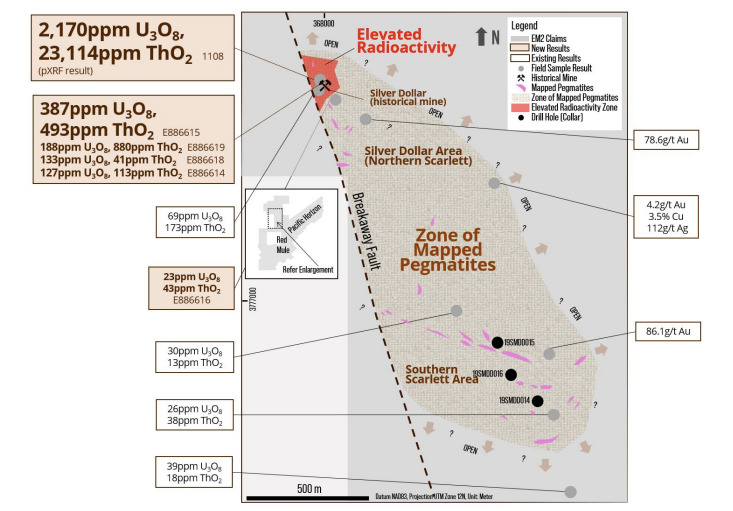Eagle Mountain firms up uranium-thorium-REE potential in first assays in over four years at Silver Mountain
Mining
Mining
Special Report: Recent field work at Silver Mountain has uncovered up to 2,170ppm uranium and 23,114ppm thorium, signalling the potential for deeper high-grade mineralisation.
Field samples collected from mapped pegmatites at Eagle Mountain Mining’s (ASX:EM2) Silver Mountain project in Arizona have returned uranium values over five times greater, on average, than results from a handheld gamma-ray spectrometer.
Several individual mineral occurrences were also assessed on other samples using a portable x-ray fluorescence analyser (pXRF), showing elevated uranium and thorium of 2,170ppm U3O8 and 23,114ppm ThO2.
Anomalous rare earth assays averaging 205ppm total rare earth elements (REEs) have also been spatially associated with the uranium and thorium, which is typical of many uranium-REE deposits around the world.
These field samples were collected from mapped pegmatites near the historical Silver Dollar mine in the Scarlett area at Silver Mountain, one of three main prospects at the site, the other two being Pacific Horizon and Red Mule.

EM2 managing director Tim Mason says this field work indicates a new geological system supported by elevated uranium, thorium and REE showings.
“It is exciting to see our first Silver Mountain assays in over four years, particularly given they support our recent field work,” he says.
“With observed similarities between field samples and new mapping across the Silver Dollar and Scarlett areas, we are eagerly following up with additional work to help establish what could be a significant exploration target for Eagle Mountain Mining.”
EM2’s consulting geologist Dr Linus Keating says there’s possibility that a ‘heat engine’ – perhaps a porphyritic intrusion – may lie beneath Silver Mountain.
“Evidence to support this possibility includes the peripheral precious metal – sericite veins at Scarlett, the increasing chloritic alteration encountered in drill holes 014, 015, and 016 as well as the lack of strong overprinted chlorite to the south, and an appearance that drilling deeper into the Pacific Horizon encounters more breccias and alteration,” he says.
“This could suggest up-dip fluid flow from a porphyritic source.”
Petrographic work is planned to help understand this unique mineral occurrence, which could potentially be an indicator of a higher-grade mineralised system at depth within the Silver Dollar area.
One particular focus area will be on features believed to be critical in controlling mineralisation intensity such as the Breakaway Fault.
Assessment of geological data from the surrounding areas, including the Pacific Horizon, is also planned given the potential for a large mineralising system to be associated with the various Silver Mountain prospects.
This article was developed in collaboration with Eagle Mountain Mining, a Stockhead advertiser at the time of publishing.
This article does not constitute financial product advice. You should consider obtaining independent advice before making any financial decisions.